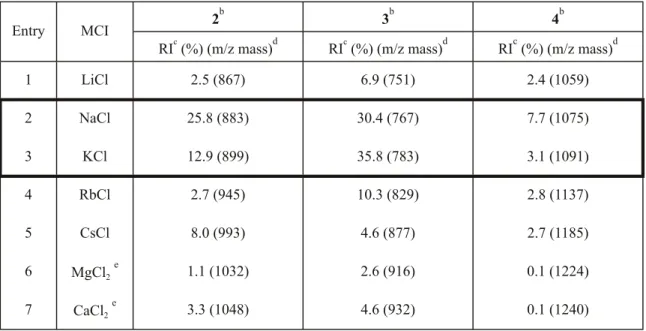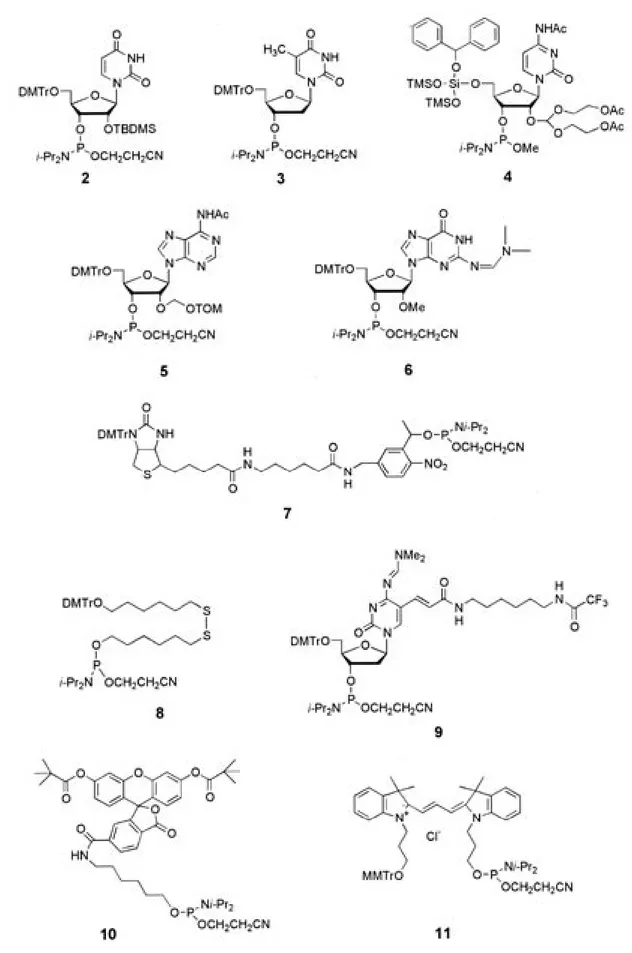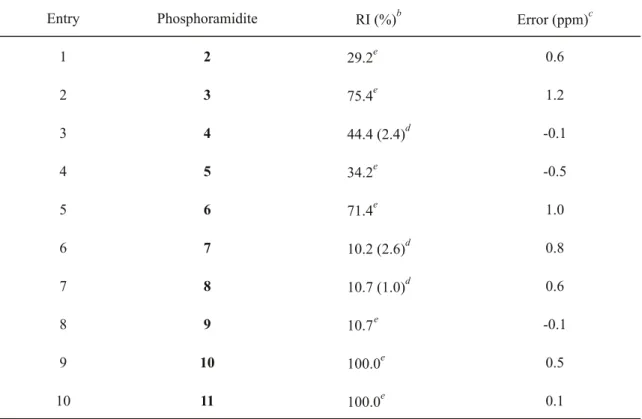107 Bulletin of Osaka University of Pharmaceutical Sciences 1 (2007)
—Regular Article—
Mass Determination of Phosphoramidites:
Effects of the Metal Ion in the Matrix and Applicability on FABMS
Mihoyo F
UJITAKE, aShinya H
ARUSAWA ,*,aZheng-yun
Z
HAO bDavid M. J. L
ILLEY, band Takushi K
URIHARA aaOsaka University of Pharmaceutical Sciences, 4-20-1, Nasahara, Takatsuki, Osaka 569-1094, Japan
and bCancer Research UK Nucleic Acid Structure Research Group, MSI/WTB Complex, The University of Dundee,
Dundee DDI 5EH, UK
(Received October 25, 2006; Accepted December 12, 2006)
We recently reported that the accurate molecular weight measurements of nucleoside or non-nucleoside phosphoramidites (PAs), which are acid-labile compounds, may be easily determined by mass spectrometry (MS) using a matrix system, triethanolamine (TEOA)-NaCl, on liquid secondary ion (LSI) MS equipped with a double-focusing mass spectrometer. This paper describes the effects of metal ions in the matrix on LSIMS and the extension of the method into FABMS measurements of various PAs under optimal conditions.
Key words——molecular weight; nucleoside; phosphoramidite; matrix; metal ion; FAB
INTRODUCTION
Mass spectrometry (MS) is now used as a very common and indispensable tool in the fields of nucleic acid chemistry. Various nucleoside and non-nucleoside phosphoramidites (PAs) are the most widely used building blocks in contemporary solid-phase synthesis of oligonucleotides.1)-4) Since crystallization of PAs is not generally possible, MS has been effective and is extensively used for the characterization of the nucleoside PAs. However, reliable methods for PA-mass measurements are lacking owing to the extremely labile properties of PAs toward acids, base, and nucleophiles. Thus, it is not always possible for the molecular-related ions (MRIs) of various PAs to be detected by the current MS methods.
Very recently, we succeeded in incorporation of an imidazole base into RNA sequence to investigate the functions of imidazole as a pseudo nucleobase in ribozyme catalysis as illustrated in Fig. 1.5), 6) A novel C4-linked imidazole ribonucleoside PA 1 7)-9) with a pivaloyloxymethyl (POM) group, which is easily removed under a basic condition and is compatible with
tert-butyldimethylsilyl (TBDMS) synthesis of RNA, has
been developed very recently as a key ribonucleoside variant for probing general acid and base catalysis in ribozyme. However, MS characterization of 1 has been difficult since it is so fragile as to be decomposed even on a standard TLC plate (e.g., Merck 60 F254).
In view of the importance of nucleoside PAs and their analogs containing 1, a recent report10) from our laboratories demonstrated convenient, rapid, and reliable methods by MS for measuring the molecular weights
(MWs) of various synthetic and commercial nucleoside PAs, making the present methods a powerful tool for the MS identification of PAs. The MS procedures are described in detail as Basic and Alternate Protocols in “Current Protocols in Nucleic Acid Chemistry, UNIT
10.11”.11) The main points of the methods are summed up as follows: 1) The accurate MS measurements of PAs may be easily determined by MS using a matrix system, triethanol amine (TEOA) - NaCl, which is a key feature of the method, on liquid secondary ion (LSI) MS equipped with a double-focusing mass spectrometer (Basic Protocol);10),11) 2) The Basic Protocol measures rapidly and easily the accurate MWs of various PAs as adduct ions [M+Na]+ with average mass error smaller than 0.2 ppm, allowing the formulas PAs in place of elemental analysis; 3) Further, it was found that intensities of MRIs could be enhanced to the highest degree by adjustment of the mole ratio of PA and NaCl fixing the amount of TEOA on LSIMS (Alternate Protocol).10),11) Our continuous interest in the MS study for PAs has led us to investigate further detailed analysis
of this method. In this report, we have investigated the effects of various metals in the matrix TEOA on LSIMS. Although we previously showed the utility of this method on FABMS for only three examples, generality of FAB-measurements of PAs has been confirmed herein under optimal conditions (Alternate Protocol).
EFFECTS OF THE METAL ION IN THE
MATRIX FOR LSIMS MEASUREMENTS
OF PAs
Use of a matrix in the presence of a metal ion has been known to be effective in the formation of an abundant metal ion adduct via LSIMS and FABMS. 12),13) Thus, alkali and alkaline earth metal-cationization of PAs has been studied using metal ions such as Li+, Na+, K+, Rb+, Cs+, Mg2+, and Ca2+ under Alternate Protocol conditions.11) Addition of LiCl to a solution of PA 2 in TEOA yielded only 2.5 % RI of the [M+Li]+ Fig. 1. Incorporation of an imidazole moiety into RNA oligonucleotides using PA1.
109 Vol.1 (2007)
ion (Table 1, 2, entry 1; The structures of PAs 2-11 are shown in Fig.2). Addition of NaCl or KCl to the solution increased the relative intensities (RIs) to 25.8% and 12.9%, respectively (2, entries 2 and 3). Conversely, the matrices in the presence of RbCl, CsCl, MgCl2, or CaCl2 led to low RIs for 2, ranging from 1.1-8.0 % (entries 4-7). Similar trends for PAs
3 and 4 were observed under identical conditions. The
preference of NaCl or KCl was similarly observed in 4 (4, entries 2 and 3). These results show that NaCl and KCl are superior to other alkali and alkaline earth metals for enhancement of the RIs of MRIs. KCl may be used as a substitute for NaCl in the matrix of PA analysis.
Table 1. Effects of Metal Ions in TEOA Matrix for MRI of PAsa
Entry MCI 2
b
3b 4b
RIc (%) (m/z mass)d RIc (%) (m/z mass)d RIc (%) (m/z mass)d
1 LiCl 2.5 (867) 6.9 (751) 2.4 (1059) 2 NaCl 25.8 (883) 30.4 (767) 7.7 (1075) 3 KCl 12.9 (899) 35.8 (783) 3.1 (1091) 4 RbCl 2.7 (945) 10.3 (829) 2.8 (1137) 5 CsCl 8.0 (993) 4.6 (877) 2.7 (1185) 6 MgCl2 e 1.1 (1032) 2.6 (916) 0.1 (1224) 7 CaCl2 e 3.3 (1048) 4.6 (932) 0.1 (1240)
a MS measurements carried out as described in the Alternate Protocol using 0.01 µmol phosphoramidite, 0.06 µmol metal (I or II) chloride, and 0.5 µL TEOA.
b 2 (C
45H61N4O9PSi): mol. wt. 860; 3 (C40H49N4O8P): mol. wt. 744; 4 (C46H73N4O16PSi3): mol. wt. 1052.
c RI, intensity relative to base peak ion (100%). d Unless otherwise noted, mass shown as [M+Metal]+.
e MRIs observed as [M+TEOA+MCl
111 Vol.1 (2007)
FABMS MEASUREMENTS OF PAs UNDER
OPTIMAL CONDITIONS
L S I M S a n d FA B M S h a v e b e e n u s e d m o s t extensively to form metal ion adducts to confirm relative molecular masses.14) Thus, usefulness of the present method on FABMS was further confirmed using the optimal conditions (Alternate Protocol). 11) The ten PAs listed in Table 2 gave MRIs with small errors
(< 1.2 ppm). Phosphoramidites 4, 7, and 8 produced RIs of only 2.4%, 2.6%, and 1.0%, respectively, when analyzed by LSIMS as described in the Basic Protocol, but their FABMS measurements under the Alternate Protocol markedly enhanced their RIs to 44.4%, 10.2%, and 10.7%, respectively (Table 2, entries 3, 6, and 7). These results show that LSIMS and FABMS are complementary approaches to PA analysis using the present matrix system.
Table 2. RIs and Errors on FABMS Measurements of Phosphoramidites under Optimal Conditionsa
Entry Phosphoramidite RI (%)b Error (ppm)c
1 2 29.2e 0.6 2 3 75.4e 1.2 3 4 44.4 (2.4)d -0.1 4 5 34.2e -0.5 5 6 71.4e 1.0 6 7 10.2 (2.6)d 0.8 7 8 10.7 (1.0)d 0.6 8 9 10.7e -0.1 9 10 100.0e 0.5 10 11 100.0e 0.1 a
MS measurements carried out according to the Alternate Protocol.
b
See Table 1.
c
Error (ppm) = 106 × (observed mass - theoretical mass) / theoretical mass.
d
Numbers in parentheses from LSIMS measurements using the Basic Protocol.
e
REFERENCES
1) Beaucage S. L, Caruthers M. H., “Current Protocols in Nucleic Acid Chemistry,” UNIT 3.3, Wiley, New York, 2003.
2) Wincott F. E., “Current Protocols in Nucleic Acid Chemistry,” UNIT 3.5, Wiley, New York, 2003.
3) Caruthers M. H., Barone A. D., Beaucage S. L., Dodds D. R., Fisher E. F., McBride L. J., Matteucci M., Stabinsky Z., Tang J. -Y., “Chemical synthesis of deoxyoligonucleotides by the phosphoramidite method. In Methods in Enzymology,” Academic Press, Inc. San Diego, 1987, 154: 287-315.
4) Reese C. B., Tetrahedron. 58, 8893-8920 (2002).
5) Zhao Z., Mcleod A., Harusawa S., Araki L., Yamaguchi M., Kurihara T., Lilley D.M.J., J. Am. Chem. Soc. 127, 5026-5027 (2005).
6) Wilson T., Ouellet J., Zhao Z, Harusawa S., Araki L., Kurihara T., Lilley D. M. J., RNA. 12, 980-987 (2006). 7) Harusawa S., Murai Y., Moriyama H., Imazu T., Ohishi
H., Yoneda R., Kurihara T., J. Org. Chem. 61, 4405-4411 (1996).
8) Araki L., Harusawa S., Yamaguchi M., Yonezawa S., Taniguchi N., Lilley D. M. J., Zhao Z., Kurihara T.,
Tetrahedron Lett. 45, 2657-2661 (2004).
9) Araki L., Harusawa S., Yamaguchi M., Yonezawa S., Taniguchi N., Lilley D. M. J., Zhao Z., Kurihara T.,
Tetrahedron, 61, 11976-11985 (2005).
10) Fujitake M., Harusawa S., Araki L., Yamaguchi M., Lilley D. M. J., Zhao Z., Kurihara T., Tetrahedron, 61, 4689-4699 (2005).
11) Harusawa S., Fujitake M., Kurihara T., Zhao Z., Lilley D. M. J., “Current Protocols in Nucleic Acid Chemistry,” UNIT 10.11, Wiley, New York, 2006; therein the Basic and Alternate protocols were described in detail.
12) Teesch L. M., Adams J., Org. Mass Spectrom. 27, 931-943 (1992).
13) Madhusudanan K. P., J. Mass Spectrom., 30, 703-707 (1995).
14) Ashcroft A.E., Ionization Methods in Organic Mass Spectrometry; The Royal Society of Chemistry Publishing: Cambridge, 1997.


